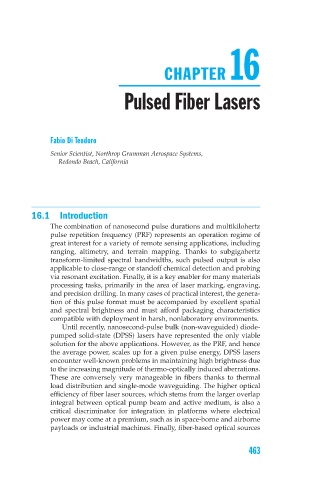Page 495 - High Power Laser Handbook
P. 495
CHAPTER 16
Pulsed Fiber Lasers
Fabio Di Teodoro
Senior Scientist, Northrop Grumman Aerospace Systems,
Redondo Beach, California
16.1 Introduction
The combination of nanosecond pulse durations and multikilohertz
pulse repetition frequency (PRF) represents an operation regime of
great interest for a variety of remote sensing applications, including
ranging, altimetry, and terrain mapping. Thanks to subgigahertz
transform-limited spectral bandwidths, such pulsed output is also
applicable to close-range or standoff chemical detection and probing
via resonant excitation. Finally, it is a key enabler for many materials
processing tasks, primarily in the area of laser marking, engraving,
and precision drilling. In many cases of practical interest, the genera-
tion of this pulse format must be accompanied by excellent spatial
and spectral brightness and must afford packaging characteristics
compatible with deployment in harsh, nonlaboratory environments.
Until recently, nanosecond-pulse bulk (non-waveguided) diode-
pumped solid-state (DPSS) lasers have represented the only viable
solution for the above applications. However, as the PRF, and hence
the average power, scales up for a given pulse energy, DPSS lasers
encounter well-known problems in maintaining high brightness due
to the increasing magnitude of thermo-optically induced aberrations.
These are conversely very manageable in fibers thanks to thermal
load distribution and single-mode waveguiding. The higher optical
efficiency of fiber laser sources, which stems from the larger overlap
integral between optical pump beam and active medium, is also a
critical discriminator for integration in platforms where electrical
power may come at a premium, such as in space-borne and airborne
payloads or industrial machines. Finally, fiber-based optical sources
463

